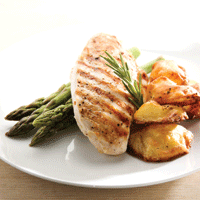 From fast food to upscale restos, chicken rules supreme
From fast food to upscale restos, chicken rules supreme
Fast food, slow food, health food, soul food — it’s almost impossible to find a restaurant that doesn’t serve chicken. Chicken crosses into every ethnic group — whether it’s kosher chicken soup, halal chicken kabobs, Indian butter chicken or Vietnamese chicken bahn mi sandwiches. It might be basic fryers for the fast-food market, organic and free-range birds raised on wild pasture, or flavourful heritage breeds.
The numbers show we’re eating more chicken than ever. According to the Ottawa-based Agriculture and Agri-Food Canada, chicken consumption has remained fairly steady at about 30 to 31.5 kg per person for most of the last decade, but that’s almost double the amount of chicken the average Canadian consumed in 1980. And, chicken finished ahead of beef and pork in popularity in the Chicago-based research firm Technomic’s 2011 Poultry Consumer Trend Report.
“Eighty-four per cent said they eat chicken at least once every 90 days — in comparison, 78 per cent said they eat beef and 58 per cent said they eat pork,” says Sara Monnette, director of Consumer Research for Technomic. “Among those who eat chicken, 89 per cent eat it once a week or more often.” That reality may be due to chicken’s popularity in foodservice — after all, it’s offered on menus more often than any type of protein. According to Technomic’s Menu Monitor database of the Top 200 chains, chicken is the second-most frequently listed entrée ingredient, after cheese.
“Chicken is featured in 28 per cent of all Top 200 entrées, a much higher percentage than either beef (12 per cent) or pork (13 per cent),” says Monnette. More than one third of consumers (35 per cent) now order chicken from quick-service restaurants at least once a week, compared to just 29 per cent in 2008. One-fifth of consumers polled in 2011 said they purchased chicken at full-service (20 per cent) and fast casual (21 per cent) restaurants once a week or more often. In comparison, fewer consumers polled in 2008 ordered chicken at these locations (16 per cent and 15 per cent respectively).
So what’s fuelling the renaissance in chicken? The growth in popularity may be due to the creative new ways it’s being presented, whether you’re grabbing a sandwich for lunch or looking for gourmet comfort food from a top chef. At Michael Noble’s new Calgary spot, Notable, chicken is literally front and centre, searing on a spit over the open flame of a wood-fired grill when you enter the restaurant.
“It’s so beautiful — it takes me back to my early years cooking Poulet de Bresse over a wood fire in France,” says the highly respected chef. “I love roast chicken and having it there on the rotisserie when people arrive gives the room action and atmosphere.” While there are other proteins rotating on Noble’s custom rotisseries daily, the free-range half chicken with house-cut fries ($24) is always a menu fixture. The chef uses it in other menu items, too, from the rotisserie chicken “grilled cheese” with double- smoked bacon and Farmhouse smoked cheddar ($16) to the rotisserie chicken “Greek Salad” with goat feta ($12 for the taster, $18 for the main).
The chickens cook over a wood fire, moving from the 300-degree box into the intense 900-degree flame in each rotation. He dry brines the birds with a salty aromatic spice rub, then stuffs each with a bit of chili-garlic butter that melts as the chicken cooks. Every Saturday, there’s also a rôtisserie chicken special, seasoned with rubs, ranging from Moroccan or Indian to a chili-chocolate rub.
“Our biggest Saturday ever, we did 78 half-chickens,” he says. “Most people don’t get through it, but they take it home in our recyclable to-go box. That’s our gift.” Noble calls his concept “cosy, charming, gourmet casual.” The suburban restaurant, with its dark booths and seating around the open kitchen bar, pulls people from all corners of the city, and a lot of them come for the chicken.
“We’re now purchasing 150 chickens a week,” he says of the birds he buys from local Sunrise Farms, a processor in Lethbridge, Alta. “Chicken is at the core of who we are and what we do.”
According to Ag Canada’s Poultry Market Report, the total amount of meat and poultry Canadians consume hasn’t changed, but chicken has soared ahead of red meat in popularity. One reason for the increased demand is health. “Compared to red meats, chicken is perceived as much leaner and therefore healthier,” concludes the report. “There is also an increased presence of substitute products featuring chicken (i.e. chicken burgers), and often it’s seen as a healthier choice compared to its red-meat alternative.” The trend is certainly evidenced in the limited-service sector. Chicken sandwiches are the top sandwich variety on menus — in 2010, Technomic found 389 chicken sandwiches listed at 131 limited service chains, with an average price of $5.37.
“We may be known for our burgers, root beer and onion rings, but a significant portion of our customers are looking for chicken as well,” says David Waterfall, director of Marketing for A&W Canada. “The growth for A&W has been in handheld chicken products.” He’s referring to new menu items such as the Chicken BLT and the spicy Chubby Chicken sandwich with pepper jack cheese and chipotle sauce.
“We’ve had chicken on the menu since the 1960s,” says Waterfall, referencing A&W’s bone-in Chubby Chicken, “but consumer tastes have changed over the years.” While A&W still sells plenty of Chubby Chicken burgers, chicken strips and grilled chicken sandwiches, flavour profiles are changing. “Consumers are looking for more adventurous, bold flavours,” Waterfall says.
Another popular chicken sandwich can be found on the KFC menu. David Vivenes, senior marketing manager for Yum Restaurants Canada, says the big Double Down chicken sandwich is the bestselling item the company has ever offered. This summer, we’ve re-introduced Double Down in Canada for a limited time with about 10-per-cent less sodium,” says Vivenes of the big sandwich that includes two pieces of crispy chicken, two pieces of cheese, two pieces of bacon and a savoury sauce. “We’re seeing increased interest from consumers in chicken sandwiches — like our famous Double Down [$6.99] — and our Hot & Spicy Zinger sandwich [from $6.99 for a combo], which is the biggest-selling KFC sandwich worldwide. The Zinger is not available in the U.S., but we brought it to Canada, because there’s a strong trend and appreciation for hot-and-spicy menu items here,” he adds.
Ironically, none of these huge chicken sandwiches come with either low calorie or fat counts — some actually clock in much higher than a basic burger — nonetheless chicken retains its healthful image.
While the Colonel’s fried chicken — with its secret spice recipe — is legendary, there are many other quick-service spots cashing in on a bucket or box of fried chicken, and they’re growing in popularity. Georgia-based Popeyes Chicken and Biscuits has more than 1,500 locations in the U.S., and is popular in Ontario. The Markham, Ont.-based Mary Brown’s now has more than 85 locations across the country. Similarly, Napanee, Ont.-based Dixie Lee has 70 franchises from coast to coast.
But there are also smaller spots in Canada specializing in fried chicken. In Calgary, the iconic Chicken-on-the-Way, featuring its colourful giant chicken statue next to a busy thoroughfare, still serves its popular fried chicken with corn fritters, while a new hot spot is Olive Chicken, offering super-crispy Korean-style fried chicken with a sweet-and-spicy sauce that makes it messy but incredibly addictive.
Chicken will always be a perennial fixture on restaurant menus, because it’s a low-price protein consumers demand. And, with increasing food prices, chicken will become an even more economical choice for chefs and diners. Twenty-five years ago, it took six to seven weeks to raise a three-pound chicken; now the average time is 32 days, which has helped keep the price of chicken low. Feed is yet another consideration. It takes two pounds of feed to produce one pound of chicken — the ratio is four to one for beef and pork.
While most of the chicken produced in Canada is directed to the retail market (62 per cent), the next biggest consumer is fast food (23 per cent), with full-service restaurants using about 10 per cent of chicken produced. And, even with plenty of cheap chicken on the market, there’s a growing niche for more expensive chicken produced without growth hormones and antibiotics. At the finest restaurants, chefs and consumers demand the best quality chicken, which often translates into a fresh, free-range, organic or even heirloom bird, fed an all-grain diet or completely pasture raised.
In Montreal, Jérôme Ferrer, Relais & Chateaux Grand Chef, features chicken on his various restaurant menus — from the haute cuisine of his flagship Europea to the gourmet French bistro fare of Beaver Hall, the Mediterranean-style Andiamo, and the jewel-box café at Birks, where the pastel Ferrer macarons are as pretty as gemstones. A new partnership, with chef Paul Baroni and Per Paolo in Brazil, promises a chicken in every pot, too.
“Chicken, is, for me, as an essential choice of meat to offer in menus, as salmon is for fish,” says Ferrer. “It deserves to be honoured. All the three-star chefs in the world honour chicken on their menus.”
Ferrer may be referring to the Poulet de Bresse with truffles, served tableside at Restaurant Paul Bocuse in his native France, or his signature Hay Chicken, a Cornish hen cooked with hay in a casserole infused with galanga, Jerusalem artichoke with shiitake and Granny Smith apples ($31.50). Ferrer says the dish fits well with his “techno-emotional cuisine,” reflecting the high quality, locally raised birds he puts on the plate.
“I like to send a message through my dishes and also have fun with my guests,” he says. “If we talk chicken, we think farm, countryside, so hay. Cooking with hay is a very old technique; it brings flavours and perfume, a real delight.” It also reflects the chef’s commitment to serve top-quality, free-range birds. I am against antibiotic-fed chicken — it’s dangerous for health and worthless,” he says. “Customers are very respectful of my choices to support local producers.”
In Toronto, Top Chef Canada’s Mark McEwan has a similar stable of foodservice spots, from sophisticated North 44 and contemporary Bymark to the more casual One Restaurant and Fabbrica. From the chicken noodle soup at One ($13) and the chicken scalopine, tomato and mozzarella Panini at Fabbrica ($13), to the crisp-skinned chicken supreme with fava bean risotto, mushroom ragout and natural jus ($33.95) at North 44, chicken fits McEwan’s refined, family style food.
Certainly, chicken is classic comfort food, which is why it works well in any locovore-style restaurant where ingredients are sourced from local or organic farms and the focus is on quality, scratch cooking. At Peasant Cookery in Winnipeg — where even the butter is made from scratch — there’s always roasted chicken soup with herb dumplings, leeks, carrot and celery on the menu ($8.99). Chicken livers are used in the Cookery’s chicken liver mousse, the poutine is served with chicken confit ($10.99), and among the comforting locally inspired main dishes of pork chops and perogies or flank steak with green bean salad, is roasted half chicken with grilled vegetables, smashed marble potatoes and natural jus ($19.99).
In Vancouver, ReFuel’s Robert Belcham is also appealing to the family, comfort-food customer with his latest chicken offering — a classic cold fried chicken picnic lunch (from $18 to $68), featuring the finest local Polderside chicken, sourced from Chilliwack. It’s also sold at the butcher shop and in the sandwiches at Big Lou’s, where chefs Allan Bosomworth and Karl Gregg create killer combinations such as its spicy Korean Bulgogi Chicken with green onion, sesame mayo and cucumber ($9).
It may be related to the economy — in difficult times people seem to crave old-fashioned comfort food, damn the calories and fat — but fried chicken is just a great family style dish that never really loses its appeal. Whether it’s on the menu at Chez Panisse in California, paired soul-food style with crispy waffles at Thomas Keller’s French Laundry, also in California, or just picked up for a picnic — a nice piece of tender chicken is always in style.
RICE
Noted for its versatility, rice can accompany any meal, but it especially complements chicken
— whether it’s stir-fried with vegetables or used as a side with chicken scallopini. The grain also has the distinction of being as plain or flavourful as a cook desires.
As far as varieties go, chefs can choose:
- long, medium or short grain rice, with varieties such as basmati, jasmine, black japonica, white, and brown available.
- rice is also available processed and pre-cooked.
Brown rice vs white rice
With consumers increasingly becoming health conscious, operators are increasingly turning to organic and brown rice as enticing options.
- The main difference between brown and white rice is that brown varieties have only the outermost layer, the hull, removed in processing, allowing the grain to retain more nutritional value.
- Brown rice therefore offers more vitamin B, iron and fibre. As for flavour and texture, brown and white rice alike boast nutty profiles, but common whites, like jasmine, are softer, moister and stickier.
- White rice, since it’s more stripped and polished, takes less time to cook and isn’t as chewy as brown.
More in Feature Articles:
Prescription for Change: Hospital foodservice gets healthier with infusion of local food
Feasting on Favourites: 50 Favourite things from Canada’s Top Chefs




















